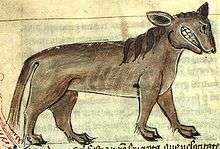Crocotta

The crocotta (or corocotta, crocuta, leucrocotta, or yena), is a mythical dog-wolf of India or Ethiopia, linked to the hyena and said to be a deadly enemy of men and dogs.
Ancient accounts

Strabo, who uses the word crocuttas, describes the beast as the mixed progeny of a wolf and a dog (Geographica, XVI.4.16).
Pliny in his work Natural History (VIII.72 and 107) variously described the crocotta as a combination between dog and wolf or between hyena and lion. Of the hyena, Pliny writes that it "is popularly believed to be bisexual and to become male and female in alternate years, the female bearing offspring without any male," and that
among the shepherds’s homesteads it simulates human speech, and picks up the name of one of them so as to call him to come out of doors and tear him to pieces, and also that it imitates a person being sick, to attract the dogs so that it may attack them; that this animal alone digs up corpses; that a female is seldom caught; that its eyes have a thousand variations of color; moreover that when its shadow falls on dogs they are struck dumb; and that it has certain magic arts by which it causes every animal at which it gazes three times to stand rooted to the spot. When crossed with this race of animals the Ethiopian lioness gives birth to the corocotta, that mimics the voices of men and cattle in a similar way. It has an unbroken ridge of bone in each jaw, forming a continuous tooth without any gum.
Pliny (VIII.72-73) also writes of another hyena-like creature, the leucrocotta, which he calls "the swiftest of all beasts, about the size of an ass, with a stag's haunches, a lion's neck, tail and breast, badger's head, cloven hoof, mouth opening right back to the ears, and ridges of bone in place of rows of teeth—this animal is reported to imitate the voices of human beings."
The Byzantine scholar Photius summarizing the book Indica, by the Greek author Ctesias, writes:
- "In Ethiopia there is an animal called crocottas, vulgarly kynolykos [dog-wolf], of amazing strength. It is said to imitate the human voice, to call men by name at night, and to devour those who approach it. It is as brave as a lion, as swift as a horse, and as strong as a bull. It cannot be overcome by any weapon of steel."
Claudius Aelianus (aka Aelian) in his book On the Characteristics of Animals (VII.22) specifically links the hyena and corocotta and mentions the creature's fabled ability to mimic human speech. Porphyry in his book On Abstinence from Animal Food (III.4), writes that "the Indian hyaena, which the natives call crocotta, speaks in a manner so human, and this without a teacher, as to go to houses, and call that person whom he knows he can easily vanquish."
According to the Augustan History (Pius, X.9), the emperor Antoninus Pius presented a corocotta, probably at his decennalia in AD 148. The historian Cassius Dio (LXXVII.1.3-5) credits the later emperor Septimius Severus with bringing the crocotta to Rome, saying this "Indian species...was then introduced into Rome for the first time, so far as I am aware. It has the color of a lioness and tiger combined, and the general appearance of those animals, as also of a dog and fox, curiously blended."
Later bestiaries of the Middle Ages confounded these various accounts, so that one finds the largely mythical creature given differing names and various characteristics, real and imaginary. Among the characteristics not found in the ancient sources was the idea that the eyes of a crocotta were striped gems that could give the possessor oracular powers when placed under the tongue.
Similarity to hyena
The scientific name of the spotted hyena (Crocuta crocuta) was taken from the mythological crocotta, and there are some similarities in the description. Hyenas do have very powerful teeth and jaws, can digest a wide range of foods, are known to dig up human bodies for food, and can make unnervingly humanlike vocalizations (such as their famous laugh). Local folklore about hyenas often gives them powers such as gender switching (males and females are difficult to distinguish), shape shifting, and human speech—all of which encourages the belief that the hyena may have contributed to the original myth of the crocotta.
Popular culture
In the Supernatural episode "Long Distance Call" a crocotta, presented as human-like with sharp teeth, uses modern communication to convince people in a small town to kill themselves, eating their souls as they die.
Jorge Luis Borges in his Book of Imaginary Beings expounds on the crocotta and the leucrocotta.
Leucrottas appear in Dungeons & Dragons.
The leucrocotta is specifically mentioned in Jonathan Strange & Mr Norrell, in the chapter "Leucrocota, the Wolf of the Evening", where the titular character names another person in the book as one, as a reference to his personality and lifestyle.[1]
Leucrotas appear in The Demigod Diaries, where Luke and Thalia encounter a small pack of them in a haunted mansion.
The card named Ravenous Leucrocota was printed in the Magic: The Gathering expansion set, Journey into Nyx.
See also
References
External links
- Medieval Bestiary: Leucrocuta
- Photius' excerpt of Ctesias' Indica (English)
- Aelian's De Naturam Animalum VII (Latin)